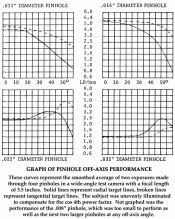Discussions on measurement of resolution is one of my pet annoyances. Why? Because they are never done by us amateur and many professionals with any regard to the lighting contrast ratio.
Resolution tests must be done at known lighting contrast ratios othewise they are meaningless. And that means your subject lighting contrast ratio and your measurements from film with known lighting contrast ratio.
Do you know what they are ? I doubt it but I'm here to be told I'm wrong.
I've seen countless claims of this resolution and that resolution and not one of them ever says under what lighting contrast ratio the measurement was taken.
So where does that leave us? Well a good starting point is to use 1000:1 for very brightly lit subjects which is 11 stops of range. And for low contrast subjects 1.6:1 because thats whats Fuji use in their film spec sheets if you look at one.
A landscape subject may have overall contrast ratio of 1000:1 from bright white clouds to dark shadows but the little fiddly bits in the bulk of the image subject will have a very small local contrast ratio which is where we are trying to get maximum detail from. So if your starting contrast ratio is only 1.6:1 it doesn't prove anything about what your lens or film is theoretically capable of under the correct conditions.
But in the real world it is the low contrast ratios of the subject that we should be worried about and YES knowing how good your lens is at those ratios may be useful. BUT if you don't set your test lighting contrast ratio to a typical subject contrast ratio then your results may and probably will be highly misleading.
For example, these tests
http://www.hevanet.com/cperez/testing.html don't mention under what lighting contrast ratio they were done so the results shown become next to meaningless.
take a look at at a Fuji film spec sheet. Say Provia 100. At 1000:1 the film will give 160 lp/mm. At 1.6:1 which is more real world local contrast ratio the figure drops to only 80 lp/mm. So tests in above might be wildly over or under representing what we might think they are representing depending on how much light was used to do the test.
So does your test include setting the lighting contrast ratio to a real world value or a value to see what your lens is theoretically capable of if the lighting was really bright or just what it happens to be on the day and place where you made the images. And if its the latter then we are entitled to take the results with a pinch of salt.
Rant over.












